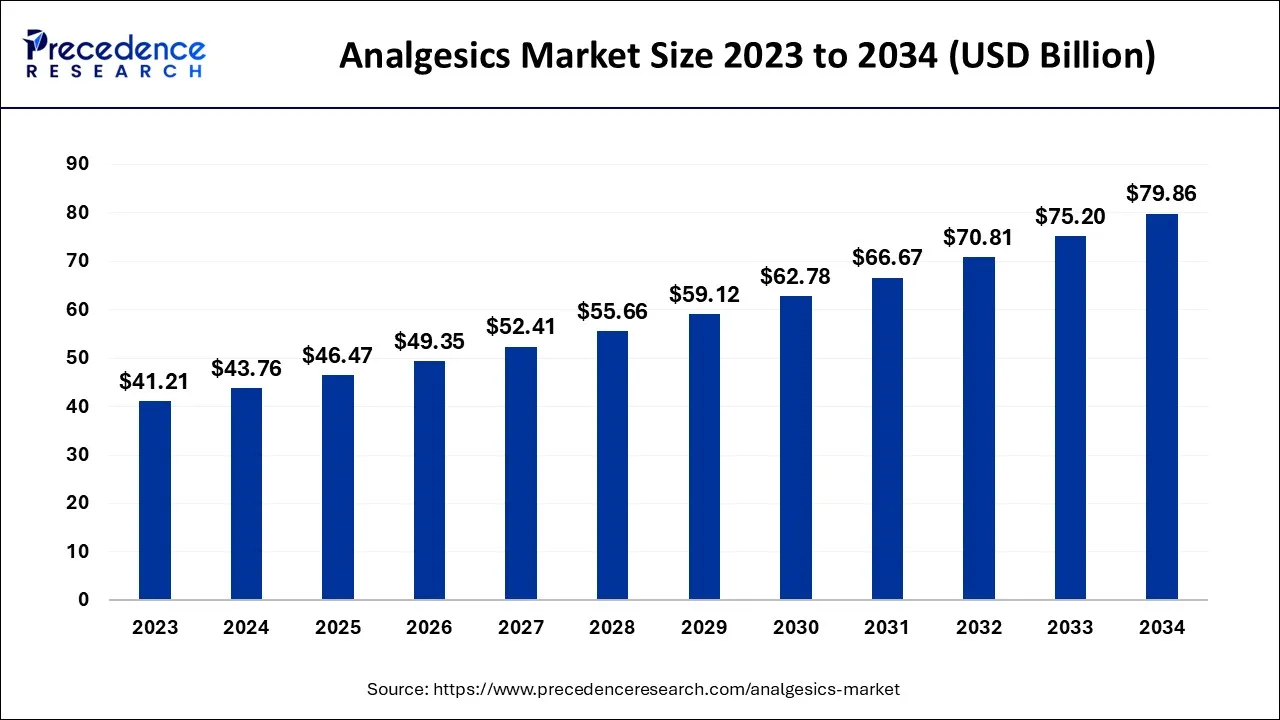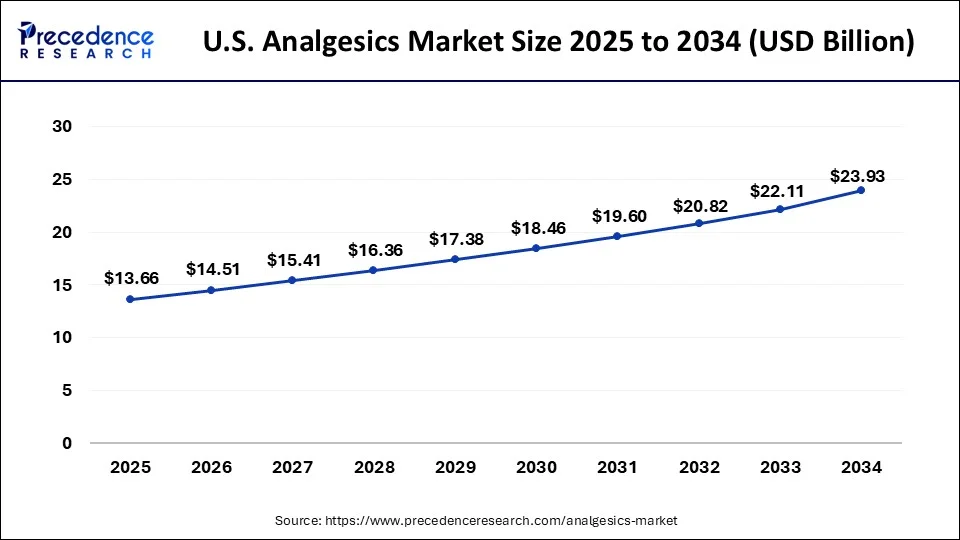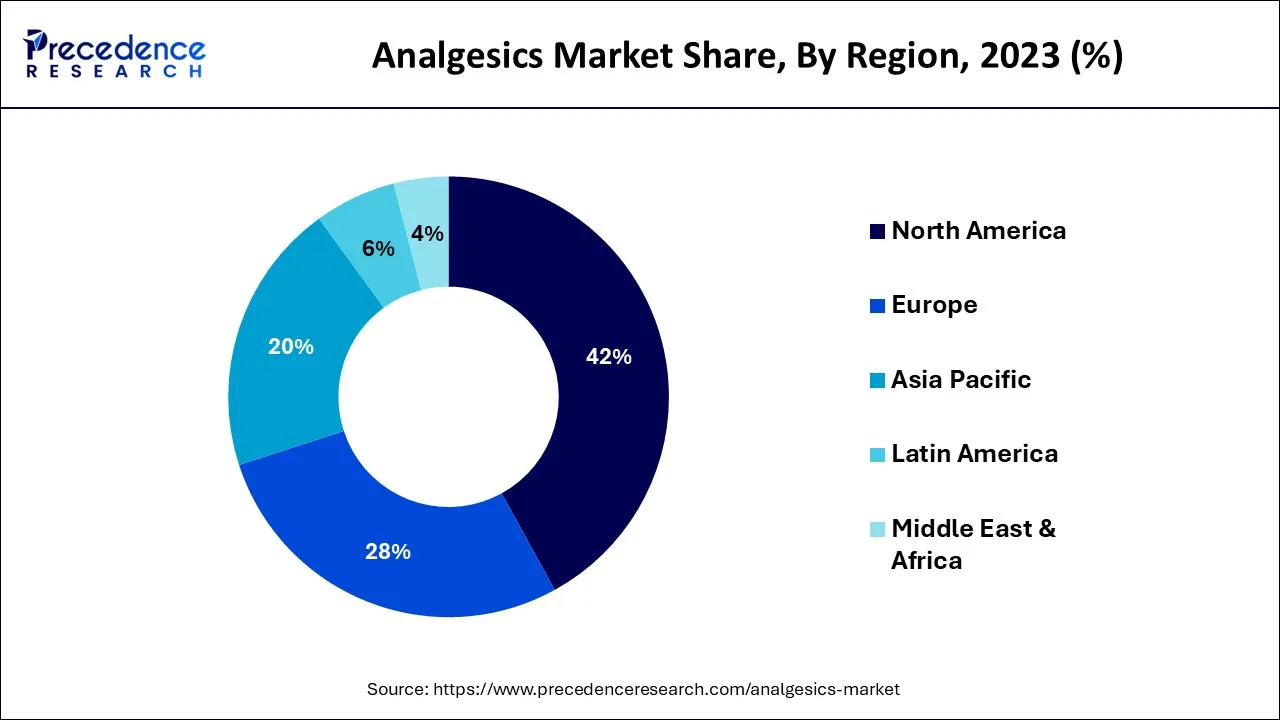Analgesics Market Size and Forecast 2025 to 2034
The global analgesics market was valued at USD 43.76 billion in 2024 and is anticipated to reach around USD 79.86 billion by 2034, expanding at a CAGR of 6.20% over the forecast period from 2025 to 2034.

Analgesics Market Key Takeaways
- North America region accounted for 42% of revenue share in 2024.
- Asia Pacific region is expected to grow at a CAGR of 7.8% from 2025 to 2034.
- By drug type, the NSAID's segment is expected to reach at a CAGR of 4.5% from 2025 to 2034.
- By indication, surgical pain has held a revenue share of over 53.5% in 2024. However, the intravenous segment is expected to grow at a CAGR of 7.7% from 2025 to 2034.
- By type, the prescription segment accounted for 71% of revenue share in 2024.
- By route of administration, the oral segment has a 48% revenue share in 2024.
U.S. Analgesics Market Size and Growth 2025 to 2034
The U.S. analgesics market size accounted for USD 12.87 billion in 2024 and is projected to be worth around USD 23.93 billion by 2034, poised to grow at a CAGR of 6.40% from 2025 to 2034.

North America accounted for the largest revenue share of the analgesics market. The increase in demand for painkiller pharmaceuticals, the presence of key players, and the development of R&D activities throughout the healthcare industry all contribute to the growth of the analgesics market in North America.
Consumers in North America show a significant demand for analgesics as a result of the rising incidence of chronic pain issues like arthritis and back pain. Furthermore, the increasing elderly population in the area is adding to the rising need for pain relief drugs. In North America, there is a strong demand for analgesics because of the rising incidence of chronic pain issues like arthritis and back pain.
The elderly population in the area is further driving the increasing need for pain relief medications. Additionally, the increasing volume of surgical procedures, along with the availability of effective pain relief medications, is anticipated to drive market growth in the coming years. In addition to this, the availability of analgesic medications as gels, creams, sprays, and oral tablets has made them more user-friendly.
- In January 2025, the U.S. Food and Drug Administration sanctioned Journavx (suzetrigine) 50 milligram oral tablets, a unique non-opioid analgesic, for the management of moderate to severe acute pain in adults. Journavx alleviates pain by focusing on a pain-signaling pathway that includes sodium channels in the peripheral nervous system, prior to the pain signals arriving at the brain.

Asia Pacific region is expected to drive strongest CAGR over the forecast period. The rising demand for analgesics, growing knowledge of their usage, increasing healthcare costs, and growing analgesics product acceptance are all contributing factors to market growth.
The growth of the analgesics market in Asia Pacific is fueled by a rise in research and development efforts for innovative medication creation, an increase in the incidence of inflammatory diseases like psoriasis, arthritis, and respiratory conditions, and a rise in the approval of new anti-inflammatory medications. Furthermore, combination therapies that incorporate multiple analgesic agents can offer synergistic effects, improving pain relief while significantly decreasing the dosage of individual medicines, thus lowering the side effects and increasing the demand for analgesics.
By performing thorough research, scientists can discover possible drug targets and carry out preclinical and clinical trials to evaluate the safety and effectiveness of new medications. This innovation results in the development of new anti-inflammatory medications that meet unmet medical needs, improve treatment results, and enhance patient care. Technologies like transdermal patches and extended-release formulations provide prolonged pain relief and enhance patient adherence.
Market Overview
Analgesics, commonly referred to as painkillers or pain relievers, are medications that reduce pain without disturbing consciousness, altering sensory perception, or interrupting the conduction of nerve impulses. These medicines include acetaminophen, often known as paracetamol or APAP in North America, salicylates, a class of nonsteroidal anti-inflammatory medications (NSAIDs), and opioids including morphine and oxycodone. Physiological injuries, operations, phantom pains, inflammation, neuropathic diseases, and cancer therapies all cause pain, which is treated with analgesics. The strongest painkillers come in the form of opioid drugs, which are made from opium. They are often used to treat moderate to severe pain and are only accessible with a prescription. Contrarily, acetaminophen is used to make non-opioid medications rather than opium. Another group of medications called NSAIDs (non-steroidal anti-inflammatory drugs) is frequently used to alleviate mild to moderate pain.
Market Scope
| Report Coverage | Details |
| Market Size in 2024 | USD 43.76 Billion |
| Market Size in 2025 | USD 46.47 billion |
| Market Size by 2034 | USD 79.86 Billion |
| Growth Rate from 2025 to 2034 | CAGR of 6.20% |
| Largest Market | North America |
| Base Year | 2024 |
| Forecast Period | 2025 to 2034 |
| Segments Covered | Drug Class, Indication, Type, Pain Type, Application, Route of Administration, Distribution Channel, and Region |
| Regions Covered | North America, Europe, Asia-Pacific, Latin America and Middle East & Africa |
Market Dynamics
The market for analgesics is growing due to the rising prevalence of chronic diseases such as arthritis, cancer, cardiovascular disease, and TB (tuberculosis). A notable rise in patients is also being caused by infectious diseases such as respiratory, gastrointestinal, and neurological problems. As the incidence of these conditions develops, so does the need for painkillers, which is anticipated to drive the analgesics market share even higher. The development of the analgesic market has also been aided by an increase in R&D efforts for the discovery of analgesic products, as well as increased investment from government and commercial organizations for the manufacture of drug manufacturing sectors. For instance, according to the World Health Organization, AIDS and malaria affected nearly 1.5 million people worldwide in 2020. Moreover, about ten million individuals are infected by tuberculosis each year and killing 1.5 million people annually despite being a preventable and curable disease.
The market for analgesics is expected to grow as a result of an increase in clinical trials being performed to evaluate the efficacy and safety of a wide range of medicinal drugs. In addition, a major factor influencing analgesics market developments is an increase in the geriatric population as well as cardiovascular diseases, cancer, and arthritis. Furthermore, the analgesic industry is expected to have prosperous futures in the coming years because of technological developments made by pharmaceutical businesses to produce sophisticated analgesic medicines. Furthermore, the prominence of large manufacturing companies that produce and distribute analgesic medicines, increasing over-the-counter drug demand, and rising healthcare spending are further factors driving the market growth.
Physical pain is one of the major factor that drive the growth of the market. For instance, according to the NCBI, it is estimated around 20% of the population globally experience physical pain, and approximately 10% are newly diagnosed with chronic pain each year. Moreover, the public health system offers special attention owing to the frequent prevalence and widespread social and health effects. Thus, the rising incidences of physical pain across the globe increasing the analgesic market demand.
Researchers and governments in many countries are monitoring the deaths due to the increasing incidence of drug overdose and other analgesics that might be hampering the growth of the market during the forecast period. For instance, according to the National Institute on Drug Abuse (NIDA), the number of people who died from opioid overdoses in 2019 was more than six times, reached over 50,000. It is crucial to identify the substances implicated in overdoses, how frequently they occur, and how their presence changes over time. Professionals can more accurately determine the best preventative and corrective strategies by recognizing drug usage. The study of overdose mortality data from the National Vital Statistics System has generally adopted the combined categories of semi-synthetic, natural, and synthetic opioids (NVSS-M).
Drug Class Insights
Based on drug class, the global analgesics market is divided into Opioids, NSAIDs, Local Anesthetics, and Acetaminophen. The opioids sector has the highest revenue share in the analgesics industry in 2024. The opioids segment will reach at a CAGR of 7.3% over the forecast period. During the analysis period, an increase in the prevalence of chronic diseases including cancer, arthritis, and TB is anticipated to propel the growth of the opioid segment. Opioids contain anti-inflammatory, analgesic, and antipyretic qualities, which help to influence the growth of market.
Indication Insights
Based on the indication, the market is divided into Surgical Pain, Cancer Pain, Neuropathic Pain, and Others. Surgical pain dominated the market with the highest market share in 2024.
Route of Administration Insights
Based on the route of administration market is divided into oral, transdermal, intravenous, topical, and rectal segments. The oral category accounted for the major revenue share in the global analgesics market in 2024. The easy, non-invasive, and efficient delivery of oral analgesics in contrast to other means of administration is credited with the segment's ongoing rise.
Additionally, an increase in the number of FDA medication approvals as well as advancements in pharmaceutical R&D efforts across various developed nations worldwide are driving the growth of the oral administration segment.
Analgesics Market Companies
- Abbott
- Pfizer Inc.
- Eli Lilly & Company
- Endo International plc
- F. Hoffmann-La Roche AG Bausch Health Companies Inc.
- Merck & Co. Inc.
- AbbVie Inc.
- Novartis AG
- Johnson & Johnson Private Limited
- GSK plc.
- Purdue Pharma L.P.
Recent Developments
- In Jun 2021, Bayer expanded its business in India with the establishment of its Consumer Health division.
- In Jan 2021, Eli Lilli and co. came into a licensing agreement with Asahi Kasei Pharma, a Japanese pharmaceutical company.
- In Jan 2021, Pfizer partnered with Premier, an American healthcare improvement company. Following this partnership, the companies would offer five essential medications to healthcare practitioners to assist them in fulfilling the long-term and immediate demands for medications essential to a range of patient care interventions.
- In Mar 2020, Eli Lilly and Company teamed up with Pfizer, an American multinational pharmaceutical and biotechnology corporation. With this collaboration, the companies increase their efforts for the US FDA approval for a Biologics License Application for its tanezumab 2.5 administered subcutaneously for patients with chronic pain.
Segment Covered in the Report
By Drug Class
- Opioids
- Morphine
- Fentanyl
- Codiene
- Methadone
- Meperidine
- Oxycodone
- Tramadol
- Dextromethorphan
- Buprenorphine
- Others
- NSAIDs
- Local Anesthetics
- Acetaminophen
By Indication
- Surgical Pain
- Cancer Pain
- Neuropathic Pain
- Others
By Type
- Prescription
- OTC
By Pain Type
- Musculoskeletal Pain
- Surgical and Trauma Pain
- Cancer Pain
- Neuropathic Pain
- Migraine
- Obstetrical Pain
- Fibromyalgia
- Pain due to Burns
- Dental/Facial Pain
- Paediatric Pain
- Others
By Application
- Internal Analgesics
- External Analgesics
By Route of Administration
- Oral
- Parenteral
- Transdermal
- Others
By Distribution Channel
- Hospital pharmacies
- Retail pharmacies
- Drug Stores
- Online pharmacies
By Geography
- North America
- Europe
- Asia-Pacific
- Latin America
- Middle East & Africa (MEA)
For inquiries regarding discounts, bulk purchases, or customization requests, please contact us at sales@precedenceresearch.com
Frequently Asked Questions
Ask For Sample
No cookie-cutter, only authentic analysis – take the 1st step to become a Precedence Research client
 sales@precedenceresearch.com
sales@precedenceresearch.com
 +1 804-441-9344
+1 804-441-9344